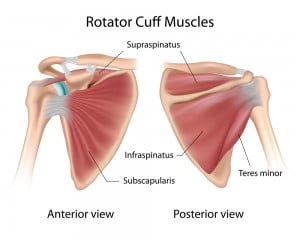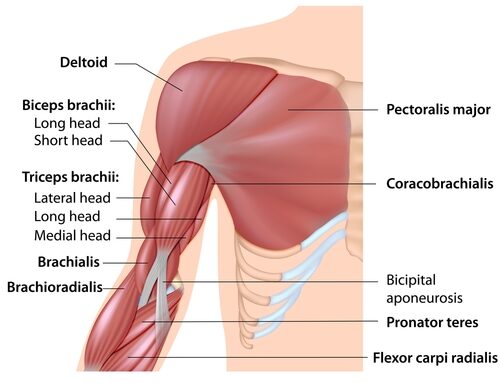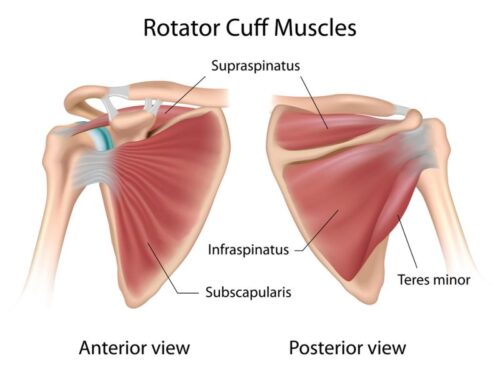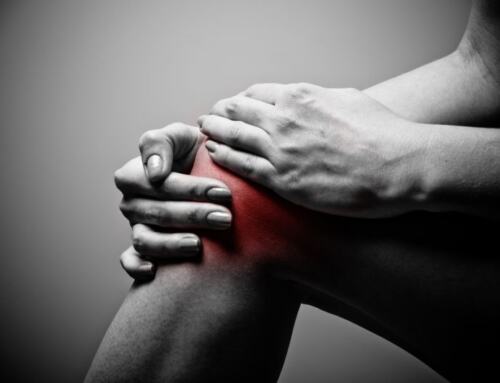Elbow and Deep Shoulder Pain?
Supraspinatus Muscle
Do you have deep shoulder pain with pain that also focuses on the outside of the elbow? If so, you might have trigger points in the supraspinatus muscle. This small muscle sits in the upper channel of the shoulder blade above the scapular spine. The supraspinatus is part of the rotator cuff which is made up of it and 3 other rotator cuff muscles pictured above. Massage therapists call them the “SITS” muscles: supraspinatus muscle, infraspinatus muscle, teres minor, and subscapularis muscle. Their main job is to keep the head of the humerus (upper arm bone) in the shoulder joint.
The shoulder joint is a complex structure that relies on the coordinated efforts of the four muscles to maintain stability and structural integrity. The supraspinatus stabilizes and also helps lift the arm away from the body (along with the deltoid muscle) and slightly rotate it outward. Unfortunately, the supraspinatus is also the most common rotator cuff injury, which has led to extensive research on its anatomy and function. Despite what we have learned so far, there is still much more to uncover about this small yet crucial muscle.
The supraspinatus pain is usually described as traveling deep into the shoulder, particularly around the deloid area. It is common for people who work with their arms elevated to have this type of shoulder pain. It is also common to hear a clicking sound in your shoulder when you raise your arm fully to the side. If you have myofascial trigger points in this shoulder muscle, you will probably have a hard time brushing your hair and teeth or shaving and also have pain during sports activities like serving a tennis ball. Referred supraspinatus trigger points can travel down the arm and forearm and into the elbow.
you raise your arm fully to the side. If you have myofascial trigger points in this shoulder muscle, you will probably have a hard time brushing your hair and teeth or shaving and also have pain during sports activities like serving a tennis ball. Referred supraspinatus trigger points can travel down the arm and forearm and into the elbow.
The Anatomy
The supraspinatus muscle receives its nerve supply from the suprascapular nerve, which is composed of fibers from the superior trunk of the brachial plexus. The muscle originates from the supraspinous fossa of the scapula and connects to the upper facet of the greater tuberosity of the humerus. Passing across the top of the shoulder joint beneath the acromion, the lower part of its tendon is closely associated with the joint capsule. Due to its location, the musculotendinous unit is prone to impingement as it moves beneath the acromion.
The glenoid fossa is a shallow depression on the scapula bone that forms part of the shoulder joint. The supraspinatus muscle plays a critical role in stabilizing the head of the humerus bone in the glenoid fossa, particularly during movements such as abduction and external rotation of the arm. Together with other muscles such as the deltoid muscle and rotator cuff muscles, the supraspinatus muscle works in conjunction with the superior glenohumeral ligament to maintain the stability and mobility of the shoulder joint. Dysfunction or injury to the supraspinatus muscle can lead to instability of the joint and impingement of the soft tissues surrounding the shoulder, causing pain and discomfort.
Cause of this elbow and shoulder pain
Carrying something heavy by your side such as a suitcase or a large dog that pulls you on your walk are a couple of things that can activate trigger points. The people that will have this type of shoulder pain most often are painters, violinists, pianists, and rock climbers. Injuries like a supraspinatus tendon rupture can activate these trigger points.
Trigger points in the supraspinatus muscle can also occur due to improper stabilization of the humeral head.
Symptoms of Supraspinatus Muscle Pain
If you have trigger points in your supraspinatus muscle, your arm and shoulder will hurt when you try to bring your arm up to your side parallel to the floor. It will hurt with activities like painting, combing your hair, or also serving a tennis ball. You want to be sure to get these  trigger points treated right away because if you wait it could impair your range of motion and lead to a frozen shoulder.
trigger points treated right away because if you wait it could impair your range of motion and lead to a frozen shoulder.
Other Diagnosis That Could Have The Same Symptoms
- Rotator Cuff Tendonitis
- Rotator Cuff Tears
- Arthritis
- Shoulder Joint Bone Spurs
- Shoulder Dislocation
- Cervical Disc Injuries
- Clavicular Injuries
- Infraspinatus Syndrome
- Other injuries to the rotator cuff tendons
Please visit your doctor to rule out any of the above diagnoses. Your doctor will likely prescribe physical therapy and massage before resorting to a more serious treatment. They will perform diagnostic testing like x-rays, ultrasound, and possibly an MRI, for instance.
The Empty Can Test and Full Can Test are commonly used orthopedic exams to assess the health and function of the supraspinatus muscle and tendon. During the exam, the patient is typically seated or standing as the examiner stabilizes the shoulder girdle with one hand and moves the arm into 90 degrees of abduction in the plane of the scapula (about 30 degrees of forward flexion) on the side being tested. The arm is then rotated internally with the thumb pointing down, as if emptying a can of beverage. The examiner applies downward pressure on the forearm while the patient resists. A positive result is indicated by significant pain and/or weakness. This test is an effective way to identify supraspinatus impingement or issues with the muscle or tendon.
Treatment for shoulder and elbow pain
 If you think you may have a tear in your rotator cuff muscles, the supraspinatus muscle should not be stretched. Treatment can include deep tissue massage. Avoid carrying a heavy object like a briefcase and do not lift things overhead. Also, drop the arms occasionally when doing things like putting curlers in your hair so the blood can flow back into the muscle which will help your elbow and shoulder pain.
If you think you may have a tear in your rotator cuff muscles, the supraspinatus muscle should not be stretched. Treatment can include deep tissue massage. Avoid carrying a heavy object like a briefcase and do not lift things overhead. Also, drop the arms occasionally when doing things like putting curlers in your hair so the blood can flow back into the muscle which will help your elbow and shoulder pain.
Body Ache Escape Massage Center can treat shoulder pain with massage! We specialize in releasing myofascial trigger points! We are located in Pickerington, Ohio just east of Columbus near Canal Winchester and Reynoldsburg. Give us a call to schedule your appointment or click the schedule now button to schedule online! 614-604-6358
We help you feel better for life, not just an hour.
Also Read:
Why Does It Hurt Between My Shoulder Blades







